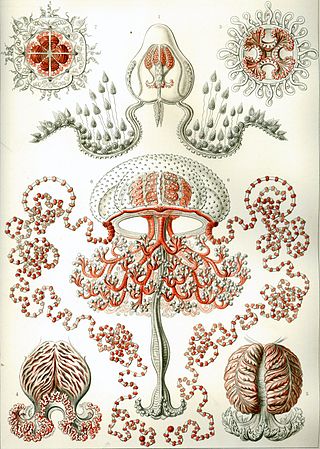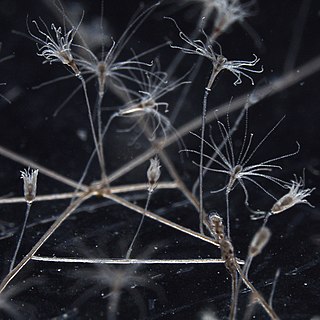
Cnidaria is a phylum under kingdom Animalia containing over 11,000 species of aquatic animals found both in freshwater and marine environments, including jellyfish, hydroids, sea anemone, corals and some of the smallest marine parasites. Their distinguishing features are a decentralized nervous system distributed throughout a gelatinous body and the presence of cnidocytes or cnidoblasts, specialized cells with ejectable flagella used mainly for envenomation and capturing prey. Their bodies consist of mesoglea, a non-living jelly-like substance, sandwiched between two layers of epithelium that are mostly one cell thick.

Hydrozoa is a taxonomic class of individually very small, predatory animals, some solitary and some colonial, most of which inhabit saline water. The colonies of the colonial species can be large, and in some cases the specialized individual animals cannot survive outside the colony. A few genera within this class live in freshwater habitats. Hydrozoans are related to jellyfish and corals and belong to the phylum Cnidaria.

Obelia is a genus of hydrozoans, a class of mainly marine and some freshwater animal species that have both polyp and medusa stages in their life cycle. Hydrozoa belongs to the phylum Cnidaria, which are aquatic organisms that are relatively simple in structure with a diameter around 1mm. There are currently 120 known species, with more to be discovered. These species are grouped into three broad categories: O. bidentata, O. dichotoma, and O. geniculata. O. longissima was later accepted as a legitimate species, but taxonomy regarding the entire genus is debated over.

Turritopsis dohrnii, also known as the immortal jellyfish, is a species of small, biologically immortal jellyfish found worldwide in temperate to tropic waters. It is one of the few known cases of animals capable of reverting completely to a sexually immature, colonial stage after having reached sexual maturity as a solitary individual. Others include the jellyfish Laodicea undulata and species of the genus Aurelia.

Anthoathecata, or the athecate hydroids, are an order of hydrozoans belonging to the phylum Cnidaria. A profusion of alternate scientific names exists for this long-known, heavily discussed, and spectacular group. It has also been called Gymnoblastea and, Anthomedusa,Athecata, Hydromedusa, and Stylasterina. There are about 1,200 species worldwide.

Chrysaora hysoscella, the compass jellyfish, is a common species of jellyfish that inhabits coastal waters in temperate regions of the northeastern Atlantic Ocean, including the North Sea and Mediterranean Sea. In the past it was also recorded in the southeastern Atlantic, including South Africa, but this was caused by confusion with close relatives; C. africana, C. fulgida and an undescribed species tentatively referred to as "C. agulhensis".

Hydroidolina is a subclass of Hydrozoa and makes up 90% of the class. Controversy surrounds who the sister groups of Hydroidolina are, but research has shown that three orders remain consistent as direct relatives: Siphonophorae, Anthoathecata, and Leptothecata.

Leptothecata, or thecate hydroids, are an order of hydrozoans in the phylum Cnidaria. Their closest living relatives are the athecate hydroids, which are similar enough to have always been considered closely related, and the very apomorphic Siphonophorae, which were placed outside the "Hydroida". Given that there are no firm rules for synonymy for high-ranked taxa, alternative names like Leptomedusa, Thecaphora or Thecata, with or without the ending emended to "-ae", are also often used for Leptothecata.

Porpita porpita, or the blue button, is a marine organism consisting of a colony of hydroids found in the warmer, tropical and sub-tropical waters of the Pacific, Atlantic, and Indian oceans, as well as the Mediterranean Sea and eastern Arabian Sea. It was first identified by Carl Linnaeus in 1758, under the basionym Medusa porpita. In addition, it is one of the two genera under the suborder Chondrophora, which is a group of cnidarians that also includes Velella. The chondrophores are similar to the better-known siphonophores, which includes the Portuguese man o' war, or Physalia physalis. Although it is superficially similar to a jellyfish, each apparent individual is actually a colony of hydrozoan polyps. The taxonomic class, Hydrozoa, falls under the phylum Cnidaria, which includes anemones, corals, and jellyfish, which explains their similar appearances.

Millepora platyphylla is a species of fire coral, a type of hydrocoral, in the family Milleporidae. It is also known by the common names blade fire coral and plate fire coral. It forms a calcium carbonate skeleton and has toxic, defensive polyps that sting. It obtains nutrients by consuming plankton and via symbiosis with photosynthetic algae. The species is found from the Red Sea and East Africa to northern Australia and French Polynesia. It plays an important role in reef-building in the Indo-Pacific region. Depending on its environment, it can have a variety of different forms and structures.

Turritopsis nutricula is a small hydrozoan that once reaching adulthood, can transfer its cells back to childhood. This adaptive trait likely evolved in order to extend the life of the individual. Several different species of the genus Turritopsis were formerly classified as T. nutricula, including the "immortal jellyfish" which is now classified as T. dohrnii.
Maeotias is a genus of hydrozoans in the family Olindiidae. It is a monotypic genus with only a single species, Maeotias marginata, commonly known as the Black Sea jellyfish or brackish water hydromedusa and often referred to as Maeotias inexpectata in the literature. It was first described from the Don and Kuban estuaries of the Sea of Azov, and also occurs in the Black Sea, all of which are areas of low salinity. It has been recorded in several other estuarine locations around the world and is regarded as an invasive species.
In biology, Gonozooids are any of the reproductive individuals of Tunicates, Bryozoan, or Hydrozoan colonies that produce gametes. Gonozooids may play a role in labour division or in alternation of generations. A gonozooid typically has hardly any other function than reproduction, amounting to little more than a motile gonad.

Clytia hemisphaerica is a small hydrozoan-group cnidarian, about 1 cm in diameter, that is found in the Mediterranean Sea and the North-East Atlantic Ocean. Clytia has the free-swimming jellyfish form typical of the Hydrozoa, as well as vegetatively propagating polyps.

Clava is a monotypic genus of hydrozoans in the family Hydractiniidae. It contains only one accepted species, Clava multicornis. Other names synonymous with Clava multicornis include Clava cornea, Clava diffusa, Clava leptostyla, Clava nodosa, Clava parasitica, Clava squamata, Coryne squamata, Hydra multicornis, and Hydra squamata. The larvae form of the species has a well developed nervous system compared to its small size. The adult form is also advanced due to its ability to stay dormant during unfavorable periods.
Eoporpita is a disc or ellipse-shaped Ediacaran fossil with unsure taxonomy/classification. It is known from its type species, Eoporpitamedusa, the only species within the genus Eoporpita.

Rosalindidae is a family of cnidarians belonging to the order Anthoathecata.
Halisiphonia is a genus of deep water hydrozoans belonging to the family Hebellidae. There is little known about individual species. This lack of information has resulted from the difficulty of studying members of this genus due to the great depths at which they are located.

Zanclea is a genus of hydrozoans belonging to the family Zancleidae.
Tima nigroannulata, commonly known as the elegant jellyfish, is a recently discovered colonial hydrozoa found on the Pacific coast of Japan.















